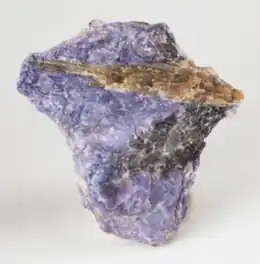Tinaksite
Tinaksite (chemical formula K2Na(Ca,Mn2+)2TiO[Si7O18(OH)])[3] is a mineral found in northern Russia. Tinaksite can be grayish-white, yellowish, orange, or brown,[2] and it is often found in charoite.[5] Its name is derived from its composition: titanium (Ti), sodium (Na) potassium (K) and silicon (Si). The International Mineralogical Association first recognized tinaksite as a mineral in 1965.
| Tinaksite | |
|---|---|
 Tinaksite (brown) and associated charoite (lilac). | |
| General | |
| Category | Silicate mineral |
| Formula (repeating unit) | K2Na(Ca,Mn2+)2TiO[Si7O18(OH)] |
| IMA symbol | Tnk[1] |
| Strunz classification | 9.DG.75 |
| Crystal system | Triclinic |
| Crystal class | Pinacoidal (1) (same H-M symbol) |
| Space group | P1 |
| Identification | |
| Color | Pink, pale yellow, light brown |
| Crystal habit | Fibrous, crystalline or prismatic, crystalline, or radial, crystalline |
| Cleavage | Perfect in one direction, indistinct in one direction |
| Mohs scale hardness | 6 |
| Luster | Vitreous to glassy |
| Streak | White |
| Diaphaneity | Transparent to translucent |
| Specific gravity | 2.82 |
| Optical properties | Biaxial (+) |
| Refractive index | nα = 1.593 nβ = 1.621 nγ = 1.666 |
| Birefringence | δ = 0.073 |
| References | [2][3][4] |
References
- Warr, L.N. (2021). "IMA–CNMNC approved mineral symbols". Mineralogical Magazine. 85 (3): 291–320. Bibcode:2021MinM...85..291W. doi:10.1180/mgm.2021.43. S2CID 235729616.
- "Tinaksite Mineral Data".
- "Tinaksite".
- Mineralienatlas
- "TINAKSITE (Potasium Sodium Calcium Manganese Titanium Iron Oxide Silicate Hydroxide)".
External links
- Rozhdestvenskaya, I. V.; Nikishova, L. V.; Lazebnik, Y. D.; Lazebnik, K. A. (1989). "The crystal structure of tokkoite and its relation to the structure of tinaksite" (PDF). Zeitschrift für Kristallographie. 189 (1–4): 195–204. doi:10.1524/zkri.1989.189.14.195. S2CID 53544093.
This article is issued from Wikipedia. The text is licensed under Creative Commons - Attribution - Sharealike. Additional terms may apply for the media files.